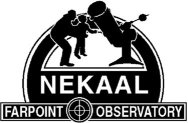
PO BOX 951, Topeka KS 66619
(785)449-2102
http://www.nekaal.org
The official newsletter of Farpoint Observatory and the Northeast Kansas Amateur Astronomers' League
 |
The NEKAAL Observer |
|
August-September, 2009 Vol. 3 No 4 PO BOX 951, Topeka KS 66619 (785)449-2102 http://www.nekaal.org The official newsletter of Farpoint Observatory and the Northeast Kansas Amateur Astronomers' League |
|